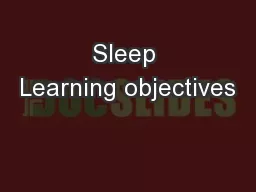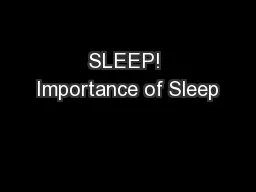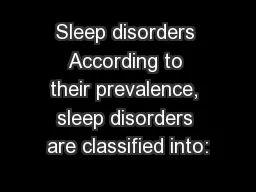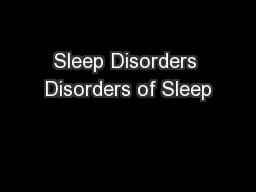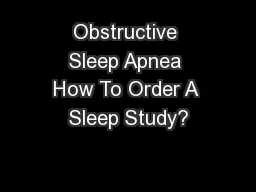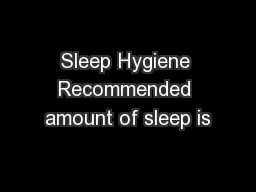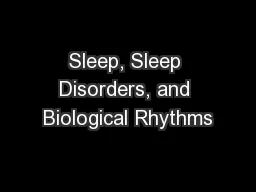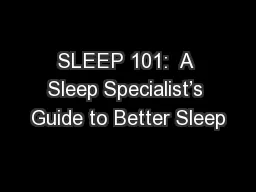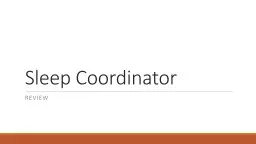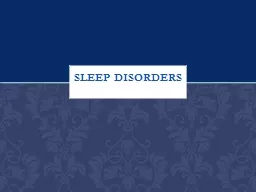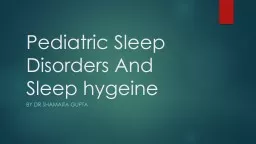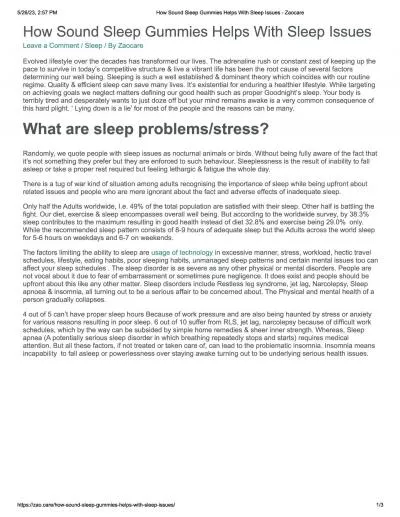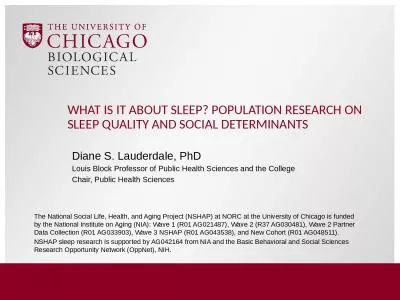PPT-Sleep Learning objectives
Author : tatyana-admore | Published Date : 2018-09-22
What are daily rhythms and how are they maintained What is sleep How do we characterize different phases of sleep What is REM and NREM sleep How does sleep change
Presentation Embed Code
Download Presentation
Download Presentation The PPT/PDF document "Sleep Learning objectives" is the property of its rightful owner. Permission is granted to download and print the materials on this website for personal, non-commercial use only, and to display it on your personal computer provided you do not modify the materials and that you retain all copyright notices contained in the materials. By downloading content from our website, you accept the terms of this agreement.
Sleep Learning objectives: Transcript
What are daily rhythms and how are they maintained What is sleep How do we characterize different phases of sleep What is REM and NREM sleep How does sleep change with age What are the health effects of sleep or lack of sleep. Fred Schwindt. Feeling Drowsy?. Do your days seem long and tiring?. Does coffee just not do it for you anymore?. Do you ever wake up feeling more tired than rested?. You probably aren’t waking up at the right time in the morning…. Patrice Ludwig, James Madison University. Carol . Hurney. , James Madison University. Janet . Branchaw. , University of Wisconsin – Madison. Kristina . Obom. , Johns Hopkins University. Need to know. Sleep Protects. :. . Sleeping in the darkness when predators loomed about kept our ancestors out of harm’s way.. Sleep Recuperates. :. . Sleep helps restore and repair brain tissue.. Sleep Helps Remembering. 1- Insomnia (the commonest): difficulty in initiating or maintaining sleep.. 2- Restless Leg Syndrome (RLS) 5-15%:. 3- Obstructive Sleep Apnea (OSA) 4%. 4- Parasomnias.. 5- Narcolepsy. . classification. 58% Adults Snore. 36% Complain of Insomnia. 15% note persistent Excessive Daytime Sleepiness. 3% Unusual Nocturnal Behaviors. 28% Workforce on night or rotating shifts. One in Three Individuals are Dissatisfied with Their Sleep. Herbert M. . Schub,MD. Chief, Pulmonary Diseases. Highland Alameda County Hospital. Clinical Professor of Medicine, UCSF. Obstructive Sleep Apnea. Obstructive Apneas,. . Hypopneas,or. . Respira. -. 7-8. hours/night or 1 hour of sleep for every 2 hours awake (adults). Current average is. 6.7. hours/night. How do you know when you are sleep deprived?. Very dependent on an alarm clock. Feeling sleepy while driving. Knowledge (what is known and not known) Choice = Power. Power Behavior = Enhanced Human Health. Sleep plays a major role in preparing . the body and brain for an . alert, productive, psychologically. Joya Paul, MD, MS. NorthShore. University . HealthSystem. Department of Neurology, Sleep Disorders. November 17, 2017. Objectives. Review background on sleep and wake. Answer some of the most frequently asked questions about sleep. Sleep Coordinator Review History of the sleep coordinator. Organizational Chart Job Description Sleep Coordinator Process (A day in the office) Vocabulary What is sleep apnea and why the strong focus. 1- Insomnia (the commonest): difficulty in initiating or maintaining sleep.. 2- Restless Leg Syndrome (RLS) 5-15%:. 3- Obstructive Sleep Apnea (OSA) 4%. 4- Parasomnias.. 5- Narcolepsy. . classification. hygeine. By Dr . Shamaita. . gupta. O. b. j. ect. i. ve. s. Understand . normal . sleep . in. . children. Review . common . pediatric. . sleep. . disorders. Discuss proper treatment . options for . Zaocare Sound sleep Gummies are essential to revitalize and invigorate your body so that you can be active through the day. People who suffer from sleeplessness wake up feeling low energy levels throughout the day. Sound sleep gummies from Zaocare works naturally with your body to improve quality of sleep. Diane S. Lauderdale, PhD. Louis Block Professor of Public Health Sciences and the College. Chair, Public Health Sciences . . The National Social Life, Health, and Aging Project (NSHAP) at NORC at the University of Chicago is funded by the National Institute on Aging (NIA): Wave 1 (R01 AG021487), Wave 2 (R37 AG030481), Wave 2 Partner Data Collection (R01 AG033903), Wave 3 NSHAP (R01 AG043538), and New Cohort (R01 AG048511)..
Download Document
Here is the link to download the presentation.
"Sleep Learning objectives"The content belongs to its owner. You may download and print it for personal use, without modification, and keep all copyright notices. By downloading, you agree to these terms.
Related Documents

